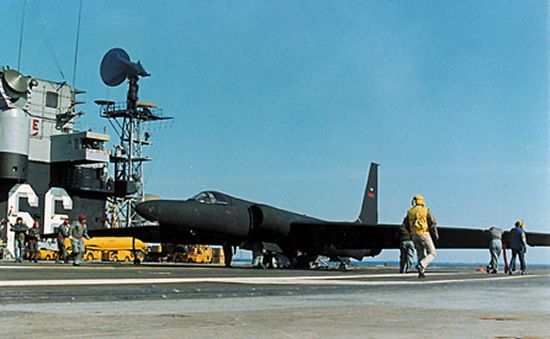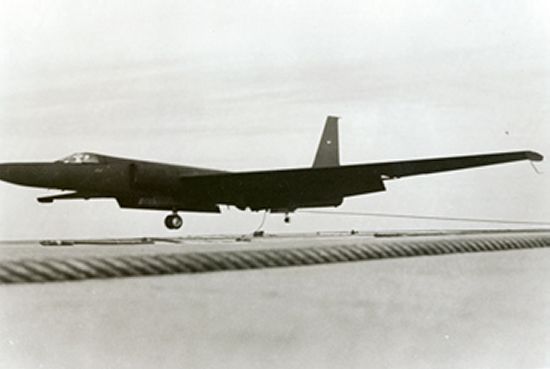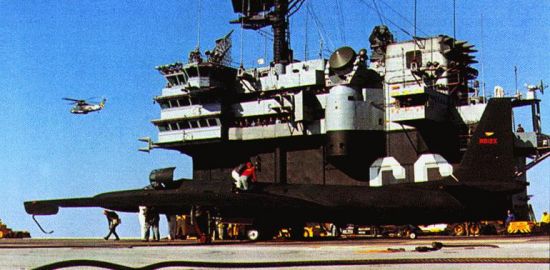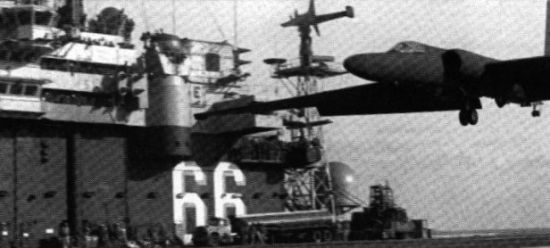|
||||||||||
|
|
||||||||||
|
||||||||||
|
|
||||||||||
The idea started in the late 1950s when the Central Intelligence Agency (CIA) was looking for a way to overcome the range limitations of the U-2. Possessing a useful range of about 3,000 miles (4,800 km), the U-2 simply could not reach every location of interest to the CIA given the locations of U-2 bases. As a result, the CIA began a cooperative effort with the US Navy known as Project Whale Tale. The purpose of this project was to adapt the U-2 for use aboard aircraft carriers. Testing commenced in August of 1963 when, in the dark of night, a crane lifted a U-2C onto the deck of the USS Kitty Hawk at San Diego, California. The vessel streamed off the coast on the morning of 5 August where Lockheed test pilot Bob Schumacher began flight test operations.

Given the U-2's large wingspan and slow liftoff speed, takeoff was accomplished relatively easily. Even fully loaded, the U-2 managed to takeoff in only 321 ft (98 m) without use of the ship's catapults. Schumacher also successfully completed several landing approaches proving that the U-2's slow approach speed and high excess power provided plenty of margin for error in case of a waveoff. Unfortunately, actually landing proved more difficult when one wingtip struck the deck and the aircraft just barely managed to become airborne again before falling over the side.
Since this initial testing looked promising, Lockheed and the Navy modified three U-2A airframes with stronger landing gear, an arresting hook, and wing spoilers to decrease the lift during landing. These new aircraft became known as the U-2G. Schumacher and several CIA pilots also became carrier-qualified by flying the T-2 Buckeye trainer and making practice landings aboard the USS Lexington. All was ready on 2 March 1964 when Schumacher made the first landing of a U-2G aboard the USS Ranger off the California coast. Although a series of touch-and-go approaches had gone well, the first landing was slightly less than successful when the arrestor hook engaged and forced the nose of the plane to dig into the deck. Despite breaking off the pitot tube, quick repairs allowed the aircraft to takeoff again. Successful takeoffs and landings continued a few days later, and the Navy considered five CIA pilots to be qualified to operate the U-2 aboard ship.

The first, and probably only, operational mission of the U-2G occurred in May 1964 when a plane operating off the USS Ranger monitored French nuclear tests at the Mururoa atoll. Otherwise, the capability to operate U-2s at sea did not appear to be in great demand. However, CIA pilots continued to be trained for carrier operations over the next few years.
In addition, the program continued when the much larger U-2R was introduced in 1967. Even being some 40% bigger than the U-2A or U-2G and with twice the range as well as four times the payload, the CIA and Navy still saw advantages to operating the aircraft from a carrier. Modifications included adding an arrestor hook and a wing-folding mechanism to fold the outer six feet of each wing for improved handling aboard ship.

Sea trials took place from 21 to 23 November 1969 aboard USS America off the Virginia coast. The tests were conducted by Lockheed test pilot Bill Park plus four CIA pilots. After undergoing abbreviated carrier training, the pilots began a series of takeoffs and landings that proved completely successful. The aircraft was even transported down the ship's elevator to the hangar deck with no significant difficulties. Even after all this effort, however, the U-2R is not believed to ever have operated from a carrier again.

While Lockheed and the Navy continued evaluating naval derivatives of the U-2 for several years, no such aircraft
ever entered service. From 1973-1974, two U-2R airframes were modified with a forward-looking radar and infrared
detection system for use in the ocean surveillance role. These U-2EPX aircraft were to downlink radar data to
surface ships to be melded with information from other land- and space-based sensors. However, the project was
deemed too expensive and unnecessary given the evolution of satellites. Yet another proposal was a two-seat U-2
variant armed with the Condor anti-ship missile, an idea that quickly died following the cancellation of Condor.
- answer by Jeff Scott, 28 October 2001
Related Topics:
Read More Articles:


|
Aircraft | Design | Ask Us | Shop | Search |

|
|
| About Us | Contact Us | Copyright © 1997-2023 | |||
|
|
|||